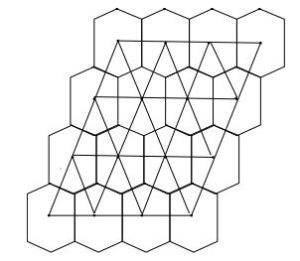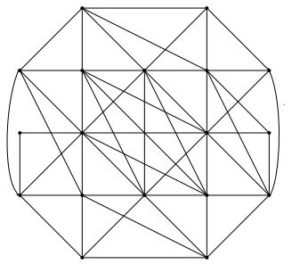Open Journal of Mathematical Sciences
ISSN: 2523-0212 (Online) 2616-4906 (Print)
DOI: 10.30538/oms2017.0007
Computing topological indices of Hex Board and its line graph
Hafiz Mutee ur Rehman\(^1\), Riffat Sardar, Ali Raza
Division of Science and Technology, University of Education, Lahore Pakistan. (M.R)
Department of Mathematics, University of Sargodha, Lahore Pakistan. (R.S)
Department of Mathematics, The University of Lahore, Lahore Pakistan.(A.R)
\(^{1}\)Corresponding Author: rehman.mutee@yahoo.com
Abstract
Keywords:
1. Introduction and Preliminaries
Mathematical chemistry is the branch of theoretical chemistry in which we discuss and predict the behavior of mathematical structure by using mathematical tools. There is lot of research which is done in this area in the last few decades. This theory contributes a major role in the field of chemical sciences.
Let \(G\) be the molecular graph in which \(V(G)\) represents the set of vertices corresponds the atoms and \(E(G)\) the set of edges to the chemical bonds. A line graph \(L(G)\) of a simple graph \(G\) is obtained by associating a vertex with each edge of the graph and connecting two vertices with an edge if and only if the corresponding edges of \(G\) have a vertex in common.
The very first topological Index Randić index introduced by Milan Randić in 1975 (see [1]). and is defined as: \[R(G)=\sum_{uv \in E(G)} \frac{1}{\sqrt{d_ud_v}}\].
Later, this index was generalized by Bollobás and Erdős( see [2]) to the following form for any real number \(\alpha\), and named the general Randić index: \begin{equation*} R(G)=\sum_{uv \in E(G)} [{d_ud_v}]^\alpha . \end{equation*} The Zagreb indices were first introduced by Gutman in [3], they are important molecular descriptors and have been closely correlated with many chemical properties (see [4]) and defined as: \begin{align*}\label{F1} M_1(G) &=\sum_{u \in V(G)} d_u^2 \hspace{10mm} \mbox{and} \\ M_2(G) &= \sum_{uv \in E(G)} d_{u}d_{v}. \end{align*} The third Zagreb index, introduced by Fath-Tabar in [5]. This index is defined as follows: \begin{eqnarray*} M_3(G) = \sum_{uv \in E(G)} |d_u- d_v|. \end{eqnarray*} The hyper-Zagreb index was first introduced in [6]. This index is defined as follows: \begin{eqnarray*} HM(G) &=& \sum_{uv \in E(G)} (d_u+d_v)^{2}. \end{eqnarray*} The Atom-Bond Connectivity index (ABC), introduced by Estrda et al. in [7] and applied up until now to study the stability of alkanes and the strain energy of cycloalkanes. The ABC index of \(G\) is defined as: \begin{equation*}\label{f4*} ABC(G)=\sum_{uv \in E(G)} \sqrt{\frac{d_u+d_v-2}{d_ud_v}}. \end{equation*} For more details see the article [8]. In 2010, the general sum-connectivity index \(\chi(G)\) has been introduced in [9]. For more detail on sum connectivity we refer the articles [9, 10]. This index is defined as follows: \begin{equation*} \chi(G)=\sum_{uv \in E(G)} \frac{1}{\sqrt{d_u+d_v}}. \end{equation*} Vukicevic and Furtula introduced the geometric arithmetic (GA) index in [11]. The GA index for \(G\) is defined by \begin{equation*} GA(G)=\sum_{uv \in E(G)} \frac{2\sqrt{d_ud_v}}{d_u+d_v}. \end{equation*} Inspired by the work on the ABC index, Furtula et al. proposed the following modified version of the ABC index and called it as Zagreb index (AZI) in [12]. This index is defined as follows: \begin{equation*}\label{F2} AZI(G)=\sum_{uv \in E(G)} (\frac{d_ud_v}{d_u+d_v-2})^3. \end{equation*} The hexagonal and honeycomb networks have also been recognized as crucial evolutionary biology, in particular for the evolution of cooperation, where the overlapping triangles are vital for the propagation of cooperation in social dilemmas. Relevant research that applies this theory and which could benefit further from the insights of the new research in (see [13]). The following lemma is helpful for computing the degree of a vertex of line graph.Lemma 1.1. Let \(G\) be a graph with \(u,v\in V(G)\) and \(e=uv \in E(G).\) Then: $$d_e=d_u+d_v-2.$$
Lemma 1.2.[14] Let \(G\) be a graph of order \(p\) and size \(q\), then the line graph \(L(G)\) of \(G\) is a graph of order \(p\) and size \(\frac{1}{2}M_{1}(G) -q\).
2. Topological indices of Hex board
In this section we will compute the topological indices of Hex board.Figure 1. Line graph of hex board with center dots.
Theorem 2.1. Let \(G\) be the Hex board \(H_n\). Then
- \(M_{1}(G) = 36n^2-80n+42;\)
- \(M_{2}(G) = 108n^2-320n+232;\)
- \(M_{3}(G) = -16n+22;\)
- \(HM(G) = 432n^2-1248n+886;\)
- \(R(G) = \frac{1}{2}n^2+\frac{1}{12}(8n-20)\sqrt{6}-\frac{5}{3}n+\frac{4}{3}\sqrt{2}+\frac{2}{3}\sqrt{3}+1\);
- \(ABC(G)=\frac{1}{6}(3n^2-16n+21)\sqrt{10}+\frac{1}{3}(8n-20)\sqrt{3}+\frac{1}{4}(4n-10)\sqrt{6}+\frac{1}{3}\sqrt{14}+\frac{2}{3}\sqrt{15}+2\sqrt{2} ;\)
- \(\chi(G) = \frac{1}{6}(3n^2-16n+21)\sqrt{3}+\frac{1}{10}(8n-20)\sqrt{10}+\frac{1}{4}(4n-10)\sqrt{2}+\frac{2}{3}\sqrt{6}+\frac{4}{7}\sqrt{7}+\frac{2}{3}\);
- \(GA(G) = 3n^2+\frac{2}{5}(8n-20)\sqrt{6}-12n+4\sqrt{2}+\frac{16}{7}\sqrt{3}+11\);
- \(AZI(G) = \frac{17496}{125}n^2-\frac{1534424}{3375}n+\frac{429997724}{1157625}\).
Proof. The graph \(G\) for \(n=4\) is shown in Figure 1. It is easy to see that the order of \(G\) is \(n^2\) out of which \(2\) vertices are of degree \(2\), \(2\) vertices are of degree \(3\), \(4(n-2)\) vertices are of degree \(4\) and \(n^2-4(n-1)\) vertices are of degree \(6\) and \(G\) has size \(3n^2-4n+1\). We partition the size of \(G\) into edges of the type \(E_{(d_u,d_v)}\) where \(uv\) is an edge. In \(G\), we get edges of the type \(E_{(2,4)}\), \(E_{(3,4)}\), \(E_{(3,6)}\), \(E_{(4,4)}\), \(E_{(4,6)}\) and \(E_{(6,6)}\). The number of edges of these types are given in the Table 1. Then we obtain the required results by using Table 1 as follows:
-
1. \begin{eqnarray*}
M_1(G) &=& \sum_{uv \in E(G)} \big[ d_u +d_v \big]\\
&=& 4(2+4)+4(3+4)+2(3+6)+(4n-10)(4+4)+(8n-20)(4+6)+(3n^2-16n+21)(6+6)\\
&=& 36n^2-80n+42.
\end{eqnarray*}
2.\begin{eqnarray*}
M_2(G)&=& \sum_{uv \in E(G)} d_{u}d_{v}\\
&=& 4(2\times4)+4(3\times4)+2(3\times6)+(4n-10)(4\times4)+(8n-20)(4\times6)+(3n^2-16n+21)(6\times6)\\
&=& 108n^2-320n+232.
\end{eqnarray*}
3.\begin{eqnarray*}
M_3(G) &=& \sum_{uv \in E(G)} |d_u- d_v|\\
&=& 4(2-4)+4(3-4)+2(3-6)+(4n-10)(4-4)+(8n-20)(4-6)+(3n^2-16n+21)(6-6).\\
&=& -16n+22.
\end{eqnarray*}
4. \begin{eqnarray*}
HM(G) &=& \sum_{uv \in E(G)} (d_u+d_v)^{2}\\
&=& 4(2+4)^2+4(3+4)^2+2(3+6)^2+(4n-10)(4+4)^2+(8n-20)(4+6)^2+(3n^2-16n+21)(6+6)^2.\\
&=& 432n^2-1248n+886.
\end{eqnarray*}
5. \begin{eqnarray*}
R(G)&=& \sum_{uv \in E(G)} \frac{1}{\sqrt{d_ud_v}}$\\
&=& 4(\frac{1}{\sqrt{2\times4}})+4(\frac{1}{\sqrt{3\times4}})+2(\frac{1}{\sqrt{3\times6}})\\&&+(4n-10)(\frac{1}{\sqrt{4\times4}})+(8n-20)(\frac{1}{\sqrt{4\times6}})+(3n^2-16n+21)(\frac{1}{\sqrt{6\times6}}).\\
&=&\frac{1}{2}n^2+\frac{1}{12}(8n-20)\sqrt{6}-\frac{5}{3}n+\frac{4}{3}\sqrt{2}+\frac{2}{3}\sqrt{3}+1.
\end{eqnarray*}
6. \begin{eqnarray*}
ABC(G)&=& \sum_{uv \in E(G)} \sqrt{\frac{d_u+d_v-2}{d_ud_v}}\\
&=& 4\sqrt{\frac{2+4-2}{2\times4}} +4\sqrt{\frac{3+4-2}{3\times4}}+2\sqrt{\frac{3+6-2}{3\times6}}+(4n-10)\sqrt{\frac{4+4-2}{4\times4}}\\
&&+(8n-20)\sqrt{\frac{4+6-2}{4\times6}}+(3n^2-16n+21)\sqrt{\frac{6+6-2}{6\times6}}.\\
&=&\frac{1}{6}(3n^2-16n+21)\sqrt{10}+\frac{1}{3}(8n-20)\sqrt{3}+\frac{1}{4}(4n-10)\sqrt{6}+\frac{1}{3}\sqrt{14}+\frac{2}{3}\sqrt{15}+2\sqrt{2}.
\end{eqnarray*}
7. \begin{eqnarray*}
\chi(G)&=& \sum_{uv \in E(G)} \frac{1}{\sqrt{d_u+d_v}}\\
&=& 4(\frac{1}{\sqrt{2+4}})+4(\frac{1}{\sqrt{3+4}})+2(\frac{1}{\sqrt{3+6}})+(4n-10)(\frac{1}{\sqrt{4+4}})\\
&&+(8n-20)(\frac{1}{\sqrt{4+6}})+(3n^2-16n+21)(\frac{1}{\sqrt{6+6}}).\\
&=& \frac{1}{6}(3n^2-16n+21)\sqrt{3}+\frac{1}{10}(8n-20)\sqrt{10}+\frac{1}{4}(4n-10)\sqrt{2}+\frac{2}{3}\sqrt{6}+\frac{4}{7}\sqrt{7}+\frac{2}{3}.
\end{eqnarray*}
8. \begin{eqnarray*}
GA(G)&=& \sum_{uv \in E(G)} \frac{2\sqrt{d_ud_v}}{d_u+d_v}\\
&=& 4(\frac{2\sqrt{2\times4}}{2+4})+4(\frac{2\sqrt{3\times4}}{3+4})+2(\frac{2\sqrt{3\times6}}{3+6})\\
&&+(4n-10)(\frac{2\sqrt{4\times4}}{4+4})+(8n-20)(\frac{2\sqrt{4\times6}}{4+6})+(3n^2-16n+21)(\frac{2\sqrt{6\times6}}{6+6}).\\
&=& 3n^2+\frac{2}{5}(8n-20)\sqrt{6}-12n+4\sqrt{2}+\frac{16}{7}\sqrt{3}+11.
\end{eqnarray*}
9. \begin{eqnarray*}
AZI(G)&=& \sum_{uv \in E(G)} \left(\frac{d_ud_v}{d_u+d_v-2}\right)^3\\
&=&4(\frac{2\times4}{2+4-2})^3+4(\frac{3\times4}{3+4-2})^3+2(\frac{3\times6}{3+6-2})^3\\
&&+(4n-10)(\frac{4\times4}{4+4-2})^3+(8n-20)(\frac{4\times6}{4+6-2})^3+(3n^2-16n+21)(\frac{6\times6}{6+6-2})^3.\\
&=& \frac{17496}{125}n^2-\frac{1534424}{3375}n+\frac{429997724}{1157625}.
\end{eqnarray*}
Table 1. The size partition of \(G\)
| \((d_u,d_v)\) where \(uv\in E(G)\) | (2,4) | (3,4) | (3,6) |
|---|---|---|---|
| Number of edges | 4 | 4 | 2 |
| \((d_u,d_v)\) where \(uv\in E(G)\) |
(4, 4) | (4, 6) | (6, 6) |
| Number of edges | 4n 10 | 8n 20 | \(3n^2-16n+21\) |
3. Topological indices of line graph of Hex board
In this section we will compute the topological indices of the line graph of Hex board.Figure 2. Line graph of hex board with center dots.
Theorem 3.1. Let \(G\) be the line graph of the Hex board \(H_n\). Then
- \(M_{1}(G) = 300n^2-944n+722;\)
- \(M_{2}(G) = 1500n^2-5616n+5194;\)
- \(M_{3}(G) = -96n+206;\)
- \(HM(G) = 6000n^2-22272n+20430;\)
- \(R(G) = \frac{3}{2}n^2-\frac{119}{15}n+\frac{1}{20}(32n-100)\sqrt{5}+\frac{3}{35}\sqrt{100}+\frac{1}{7}\sqrt{14}+\frac{1}{12}(16n-48)\sqrt{3}+\frac{2}{5}\sqrt{10}+\frac{4}{35}\sqrt{35}+\frac{2}{15}\sqrt{30}+\frac{1}{2}\sqrt{2}+\frac{2}{3}\sqrt{6}+\frac{247}{20}\);
- \(ABC(G) =\frac{3}{10}(15n^2-96n+152)\sqrt{2}+\frac{1}{5}(32n-100)\sqrt{5}+\frac{1}{6}(4n-12)\sqrt{10}+8n+\frac{1}{8}(8n-14)\sqrt{14}+\frac{3}{7}\sqrt{42}+\frac{1}{7}\sqrt{82}+\frac{2}{5}\sqrt{110}+\frac{4}{7}\sqrt{14}+\frac{2}{5}\sqrt{30}+\frac{4}{5}\sqrt{2}+\sqrt{5}+\frac{8}{3}\sqrt{3}+\frac{1}{2}\sqrt{6}-24;\)
- \(\chi(G) = \frac{1}{10}(15n^2-96n+152)\sqrt{5}+\frac{1}{6}(32n-100)\sqrt{2}+\frac{1}{14}(16n-48)\sqrt{14}+\frac{1}{6}(4n-12)\sqrt{3}+2n-\frac{7}{2}+\frac{6}{17}\sqrt{17}+\frac{4}{15}\sqrt{15}+\frac{8}{13}\sqrt{13}+\frac{4}{11}\sqrt{11}+\frac{4}{3}\sqrt{3}+\sqrt{10}+\frac{1}{2}\sqrt{2}\);
- \(GA(G) = 15n^2+\frac{4}{9}(32n-100)\sqrt{5}+\frac{4}{7}(16n-48)\sqrt{3}-84n+\frac{12}{17}\sqrt{70}+\frac{16}{15}\sqrt{14}+\frac{32}{13}\sqrt{10}+\frac{2}{3}\sqrt{35}+\frac{8}{11}\sqrt{30}+\frac{8}{3}\sqrt{2}+\frac{16}{5}\sqrt{6}+130\);
- \(AZI(G) = \frac{625000}{243}n^2-\frac{109249838528}{10418625}n+\frac{1427097955303080667}{133703165756160}\).
Proof. The graph \(G\) for \(n=4\) is shown in Figure 2. By using Lemma 1.1, It is easy to see that the order of \(G\) is \(3n^2-4n+1\) out of which \(4\) vertices are of degree \(4\), \(4\) vertices are of degree \(5\), \(2\) vertices are of degree \(7\), \(4n-10\) vertices are of degree \(6\), \(8n-20\) vertices are of degree \(8\) and \(3n^2-16n+21\) vertices are of degree \(10\). Therefore by using Lemma 1.2, \(G\) has size \(15n^2-36n+20\). We partition the size of \(G\) into edges of the type \(E_{(d_u,d_v)}\) where \(uv\) is an edge. In \(G\), we get edges of the type \(E_{(4,4)}\), \(E_{(4,6)}\), \(E_{(4,8)}\), \(E_{(5,5)}\), \(E_{(5,6)}\), \(E_{(5,7)}\), \(E_{(5,8)}\), \(E_{(6,6)}\), \(E_{(6,8)}\), \(E_{(7,8)}\), \(E_{(7,10)}\), \(E_{(8,8)}\), \(E_{(8,10)}\) and \(E_{(10,10)}\). The number of edges of these types are given in the Table 2. Then we obtain the required results by using Table 2 as follows:
-
1. \begin{eqnarray*}
M_1(G)&=&\sum_{uv \in E(G)} \big[ d_u +d_v \big]\\
&=&2(4+4)+8(4+6)+4(4+8)+2(5+5)+4(5+6)+4(5+7)+8(5+8)+(4n-12)(6+6)\\
&&+(16n-48)(6+8)+4(7+8)+6(7+10)+(8n-14)(8+8)+(32n-100)(8+10)+(15n^2-96n+152)(10+10).\\
&=& 300n^2-944n+722.
\end{eqnarray*}
2. \begin{eqnarray*}
M_2(G) &=&\sum_{uv \in E(G)} d_{u}d_{v}\\
&=& 2(4\times4)+8(4\times6)+4(4\times8)+2(5\times5)+4(5\times6)+4(5\times7)+8(5\times8)+(4n-12)(6\times6)\\
&& +(16n-48)(6\times8)+4(7\times8)+6(7\times10)+(8n-14)(8\times8)+(32n-100)(8\times10)+(15n^2-96n+152)(10\times10).\\
&=& 1500n^2-5616n+5194.
\end{eqnarray*}
3. \begin{eqnarray*}
M_3(G) &=& \sum_{uv \in E(G)} |d_u- d_v|\\
&=& 2(4-4)+8(4-6)+4(4-8)+2(5-5)+4(5-6)+4(5-7)+8(5-8)+(4n-12)(6-6)\\
&&+(16n-48)(6-8)+4(7-8)+6(7-10)+(8n-14)(8-8)+(32n-100)(8-10)+(15n^2-96n+152)(10-10).\\
&=& -96n+206.
\end{eqnarray*}
4. \begin{eqnarray*}
HM(G)&=& \sum_{uv \in E(G)} (d_u+d_v)^{2}\\
&=& 2(4+4)^2+8(4+6)^2+4(4+8)^2+2(5+5)^2+4(5+6)^2+4(5+7)^2+8(5+8)^2+(4n-12)(6+6)^2+(16n-48)(6+8)^2\\
&&+4(7+8)^2+6(7+10)^2+(8n-14)(8+8)^2+(32n-100)(8+10)^2+(15n^2-96n+152)(10+10)^2.\\
&=& 6000n^2-22272n+20430.
\end{eqnarray*}
5. \begin{eqnarray*}
R(G)&=& \sum_{uv \in E(G)} \frac{1}{\sqrt{d_ud_v}}\\
&=& 2(\frac{1}{\sqrt{4\times4}})+8(\frac{1}{\sqrt{4\times6}})+4(\frac{1}{\sqrt{4\times8}})+2(\frac{1}{\sqrt{5\times5}})\\
&& +4(\frac{1}{\sqrt{5\times6}})+4(\frac{1}{\sqrt{5\times7}})+8(\frac{1}{\sqrt{5\times8}})+(4n-12)(\frac{1}{\sqrt{6\times6}})\\
&& +(16n-48)(\frac{1}{\sqrt{6\times8}})+4(\frac{1}{\sqrt{7\times8}})+6(\frac{1}{\sqrt{7\times10}})+(8n-14)(\frac{1}{\sqrt{8\times8}})\\
&& +(32n-100)(\frac{1}{\sqrt{8\times10}})+(15n^2-96n+152)(\frac{1}{\sqrt{10\times10}}).\\
&=& \frac{3}{2}n^2-\frac{119}{15}n+\frac{1}{20}(32n-100)\sqrt{5}+\frac{3}{35}\sqrt{100}+\frac{1}{7}\sqrt{14}\\
&&+ \frac{1}{12}(16n-48)\sqrt{3}+\frac{2}{5}\sqrt{10}+\frac{4}{35}\sqrt{35}+\frac{2}{15}\sqrt{30}\\
&&+ \frac{1}{2}\sqrt{2}+\frac{2}{3}\sqrt{6}+\frac{247}{20}.
\end{eqnarray*}
6. \begin{eqnarray*}
ABC(G)&=&\sum_{uv \in E(G)} \sqrt{\frac{d_u+d_v-2}{d_ud_v}}\\
&=& 2(\sqrt{\frac{4+4-2}{4\times4}})+8(\sqrt{\frac{4+6-2}{4\times6}})+4(\sqrt{\frac{4+8-2}{4\times8}})\\
&& +2(\sqrt{\frac{5+5-2}{5\times5}})+4(\sqrt{\frac{5+6-2}{5\times6}})+4(\sqrt{\frac{5+7-2}{5\times7}})\\
&& +8(\sqrt{\frac{5+8-2}{5\times8}})+(4n-12)(\sqrt{\frac{6+6-2}{6\times6}})+(16n-48)(\sqrt{\frac{6+8-2}{6\times8}})\\
&& +4(\sqrt{\frac{7+8-2}{7\times8}})+6(\sqrt{\frac{7+10-2}{7\times10}})+(8n-14)(\sqrt{\frac{8+18-2}{8\times8}})\\
&& +(32n-100)(\sqrt{\frac{8+10-2}{8\times10}})+(15n^2-96n+152)(\sqrt{\frac{10+10-2}{10\times10}}).\\
&=& \frac{3}{10}(15n^2-96n+152)\sqrt{2}+\frac{1}{5}(32n-100)\sqrt{5}+\frac{1}{6}(4n-12)\sqrt{10}+8n\\
&& +\frac{1}{8}(8n-14)\sqrt{14}+\frac{3}{7}\sqrt{42}+\frac{1}{7}\sqrt{82}+\frac{2}{5}\sqrt{110}+\frac{4}{7}\sqrt{14}\\
&& +\frac{2}{5}\sqrt{30}+\frac{4}{5}\sqrt{2}+\sqrt{5}+\frac{8}{3}\sqrt{3}+\frac{1}{2}\sqrt{6}-24;
\end{eqnarray*}
7. \begin{eqnarray*}
\chi(G)&=& \sum_{uv \in E(G)} \frac{1}{\sqrt{d_u+d_v}}\\
&=& 2(\frac{1}{\sqrt{4+4}})+8(\frac{1}{\sqrt{4+6}})+4(\frac{1}{\sqrt{4+8}})+2(\frac{1}{\sqrt{5+5}})\\
&& +4(\frac{1}{\sqrt{5+6}})+4(\frac{1}{\sqrt{5+7}})+8(\frac{1}{\sqrt{5+8}})+(4n-12)(\frac{1}{\sqrt{6+6}})\\
&& +(16n-48)(\frac{1}{\sqrt{6+8}})+4(\frac{1}{\sqrt{7+8}})+6(\frac{1}{\sqrt{7+10}})+(8n-14)(\frac{1}{\sqrt{8+8}})\\
&& +(32n-100)(\frac{1}{\sqrt{8+10}})+(15n^2-96n+152)(\frac{1}{\sqrt{10+10}}).\\
&=&\frac{1}{10}(15n^2-96n+152)\sqrt{5}+\frac{1}{6}(32n-100)\sqrt{2}+\frac{1}{14}(16n-48)\sqrt{14}\\
&& +\frac{1}{6}(4n-12)\sqrt{3}+2n-\frac{7}{2}+\frac{6}{17}\sqrt{17}+\frac{4}{15}\sqrt{15}+\frac{8}{13}\sqrt{13}\\
&& +\frac{4}{11}\sqrt{11}+\frac{4}{3}\sqrt{3}+\sqrt{10}+\frac{1}{2}\sqrt{2}.
\end{eqnarray*}
8. \begin{eqnarray*}
GA(G)&=& \sum_{uv \in E(G)} \frac{2\sqrt{d_ud_v}}{d_u+d_v}\\
&=& 2 \frac{2\sqrt{4\times4}}{4+4}+8 \frac{2\sqrt{4\times6}}{4+6}+4 \frac{2\sqrt{4\times8}}{4+8}\\
&& +2 \frac{2\sqrt{5\times5}}{5+5}+4 \frac{2\sqrt{5\times6}}{5+6}+4 \frac{2\sqrt{5\times7}}{5+7}+8 \frac{2\sqrt{5\times8}}{5+8}\\
&& +(4n-12) \frac{2\sqrt{6\times6}}{6+6}+(16n-48) \frac{2\sqrt{6\times8}}{6+8}+4 \frac{2\sqrt{7\times8}}{7+8}\\
&&+6 \frac{2\sqrt{7\times10}}{7+10}+(8n-14) \frac{2\sqrt{8\times8}}{8+8}+(32n-100) \frac{2\sqrt{8\times10}}{8+10}+(15n^2-96n+152) \frac{2\sqrt{10\times4}}{10+10}.\\
&=& 15n^2+\frac{4}{9}(32n-100)\sqrt{5}+\frac{4}{7}(16n-48)\sqrt{3}-84n+\frac{12}{17}\sqrt{70}\\
&& +\frac{16}{15}\sqrt{14}+\frac{32}{13}\sqrt{10}+\frac{2}{3}\sqrt{35}+\frac{8}{11}\sqrt{30}+\frac{8}{3}\sqrt{2}+\frac{16}{5}\sqrt{6}+130.
\end{eqnarray*}
9. \begin{eqnarray*}
AZI(G)&=& \sum_{uv \in E(G)} (\frac{d_ud_v}{d_u+d_v-2})^3\\
&=& 2(\frac{4\times4}{4+4-2})^3+8(\frac{4\times6}{4+6-2})^3+4(\frac{4\times8}{4+8-2})^3\\
&&+2(\frac{5\times5}{5+5-2})^3+4(\frac{5\times6}{5+6-2})^3+4(\frac{5\times7}{5+7-2})^3+
8(\frac{5\times8}{5+8-2})^3+(4n-12)(\frac{6\times6}{6+6-2})^3+(16n-48)(\frac{6\times8}{6+8-2})^3\\
&& +4(\frac{7\times8}{7+8-2})^3+6(\frac{7\times10}{7+10-2})^3+(8n-14)(\frac{8\times8}{8+8-2})^3\\
&& +(32n-100)(\frac{8\times10}{8+10-2})^3+(15n^2-96n+152)(\frac{10\times10}{10+10-2})^3$\\
&=& \frac{625000}{243}n^2-\frac{109249838528}{10418625}n+\frac{1427097955303080667}{133703165756160}$.
\end{eqnarray*}
Table 2. The size partition of \(G\)
| \((d_u,d_v)\) where \(uv\in E(G)\) | (4, 4) | (4, 6) | (4, 8) | (5,5) | (5, 6) |
|---|---|---|---|---|---|
| Number of edges | 2 | 8 | 4 | 2 | 4 |
| \((d_u,d_v)\) where \(uv\in E(G)\) | (5, 7) | (5, 8) | (6, 6) | (6, 8) | (7, 8) |
| Number of edges | 4 | 8 | 4n - 12 | 16n - 48 | 4 |
| \((d_u,d_v)\) where \(uv\in E(G)\) | (7, 10) | (8, 8) | (8, 10) | (10, 10) | |
| Number of edges | 6 | 8n - 14 | 32n - 100 | 15\(n^2\) - 96n + 152 |
Competing Interests
The author(s) do not have any competing interests in the manuscript.References
- Rendić , M. (1975). Characterization of molecular branching. Journal of the American Chemical Society, 97(23), 6609-6615. [Google Scholor]
- Bollobás, B., & Erdös, P. (1998). Graphs of extremal weights. Ars Combinatoria, 50, 225-233. [Google Scholor]
- Gutman, I., & Trinajstić, N. (1972). Graph theory and molecular orbitals. Total \(\varphi\)-electron energy of alternant hydrocarbons. Chemical Physics Letters, 17(4), 535-538.[Google Scholor]
- Todeschini, R., & Consonni, V. (2008). <>iHandbook of molecular descriptors (Vol. 11). John Wiley & Sons. [Google Scholor]
- Fath-Tabar, G. H. (2011). Old and new Zagreb indices of graphs. MATCH Commun. Math. Comput. Chem, 65, 79-84.[Google Scholor]
- Shirdel, G. H., Rezapour, H., & Sayadi, A. M. (2013). The hyper-Zagreb index of graph operations. Iranian Journal of Mathematical Chemistry, 4(2), 213-220. [Google Scholor]
- Estrada, E., Torres, L. Rodriguez, L., & Gutman, I. (1998) An atom-bond connectivity index, Modelling the enthalpy of formation of alkanes. \emph{Indian J. Chem. 37}, 849-855. [Google Scholor]
- Furtula, B., Graovac, A., & Vukicevic, D. (2009). Atom–bond connectivity index of trees. Discrete Applied Mathematics, 157(13), 2828-2835. [Google Scholor]
- Zhou, B., & Trinajstic, N. (2010). On general sum-connectivity index. Journal of mathematical chemistry, 47(1), 210-218. [Google Scholor]
- Zhou, B., & Trinajstic, N. (2009). On a novel connectivity index. Journal of mathematical chemistry, 46(4), 1252-1270. [Google Scholor]
- Vukicevic, D., & Furtula, B. (2009). Topological index based on the ratios of geometrical and arithmetical means of end-vertex degrees of edges. Journal of mathematical chemistry, 46(4), 1369-1376.[Google Scholor]
- Furtula, B., Graovac, A. & Vukičević, D. (2010). Augmented Zagreb index. J. Math. Chem. 48, 370-380.
- Perc, M., Gómez-Gardeñes, J., Szolnoki, A., Floría, L. M., & Moreno, Y. (2013). Evolutionary dynamics of group interactions on structured populations: a review. Journal of the royal society interface, 10(80), 20120997.[Google Scholor]
- Gutman, I., & Das, K. C. (2004). The first Zagreb index 30 years after. MATCH Commun. Math. Comput. Chem, 50, 83-92. [Google Scholor]


